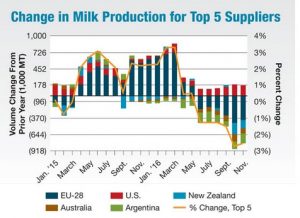In a world market so tight for dairy products, one country’s demise—or perhaps four of them—is another’s gain. Falling production in the four other major global dairy exporting regions—Argentina, Australia, New Zealand and the European Union (EU)—and steady demand sparked higher world prices and a turnaround for U.S. dairy producer milk checks.
Dairy producers faced a steady decline in milk prices after historic highs in 2014. The market bottomed out in the summer of 2016 when the all-milk price dropped to $14.50 per cwt in May, a full $10 per cwt lower than its peak in September 2014. Dairy producers saw the tightest margins since the dairy market collapse in 2009 despite forgiving feed prices. 
But prices rebounded significantly in the second half of 2016, peaking at $18.80 in December. This year looks to be much better. Milk market experts Mark Stephenson and Bob Cropp from the University of Wisconsin-Madison speculate the Class III milk price (the price paid for milk that goes into cheese production—the largest price category) will average from the high $17 to low $18 for 2017. That, combined with a continued supply of cheap feed, should provide better margins for dairy producers than what was witnessed for the balance of 2016.
The reason for the positive response is simple supply and demand economics. While the U.S. dairy industry was hurting, markets around the world were in worse shape. An oversupply of milk in the EU forced prices to plummet and caused governments there to offer financial incentives for producers to cut production. Production cutbacks in other countries were weather-related. Flooding in Argentina and drought in Australia cut production and prices in those areas.
In the meantime, world demand for dairy products continues to grow, especially in China, where import volume grew 18% through the first eight months of 2016.
“Chinese dairy consumption continues to rise with the expansion of food service and bakery outlets and consumers drawn to dairy tastes, applications and nutritional benefits,” says Tom Suber, former CEO of the U.S. Dairy Export Council (USDEC).
Demand growth in China and other countries, coupled with the widespread drop in production, eventually caused world dairy prices to turn around, aligning with U.S. domestic prices.
The U.S. market benefited in two ways. First, milk production increased. U.S. dairy cows didn’t pay attention to depressed prices and kept right on producing milk at higher levels. There were more cows, too: USDA reports about 16,000 head were added to the milk cow inventory in 2016. That’s a nearly 2% increase in milk production, making the U.S. the only major exporting country to increase production.
The second factor was continued growth in dairy exports. According to USDEC, in 2016 more than 15% of U.S. milk was exported. That’s up from just under 8% in 2009. As Michael Dykes, president and CEO of the International Dairy Foods Association puts it, “one day each week we sent all of the milk we produced that day out of the country.” 
Dairy producers benefited from a perfect storm of opportunity in 2016. But just as trade influenced the price rejuvenation, it will have a lot to say about milk prices this year.
Similar to other commodities, dairy producers need strong export markets to keep milk prices steady. As production continues to grow—and there is no sign it will slow down—and domestic demand remains flat, the dairy industry will look to export markets to soak up additional supply.
Source: AGWeb
